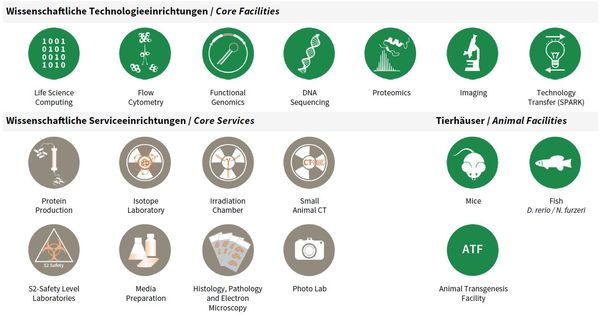Core Facilites and Core Services
At the beginning of 2016, a “core” structure was put into effect that organized facility and service units as independent organizational entities from FLI’s research groups. A number of technology platforms (e.g. sequencing, mass spectrometry) grew out of individual methodological requirements for single research groups in the last years but developed into semiautonomous substructures. As consequence of re-focused research activities and the concomitant advent of new research groups at FLI, those units increasingly had to serve many FLI groups and collaborative research efforts in the Jena research area.
To accommodate this development and to increase efficiency as well as transparency for users, facility personnel and for administrative processes, it came natural to re-organize such activities into independent units as “FLI Core Facilities and Services” and to phase out infrastructures considered non-essential for FLI’s research focus (X-ray crystallography and NMR spectroscopy).
FLI’s Core Facilities (CF) are managed by a CF Manager and are each scientifically guided in their activities and development by an FLI Group Leader, as Scientific Supervisor. The animal facilities comprising fish, mouse and transgenesis are run separately, as they involve a more complex organizational structure. Basic Core Services (CS) are directly led by the Head of Core (HC), who in turn is supported by individual CS Managers.
All facilities and services, including animal facilities, have a valuable contribution to FLI’s research articles; e.g. from 2016–2018, to 54% of all peer reviewed research publications.
Overview Core Facilities and Core Services at FLI.
Publications
(since 2016)
2023
- Protecting RNA quality for spatial transcriptomics while improving immunofluorescent staining quality.
Hahn N, Bens M, Kempfer M, Reißig C, Schmidl L, Geis C
Front Neurosci 2023, 17, 1198154 - Impact of inflammatory preconditioning on murine microglial proteome response induced by focal ischemic brain injury
Helbing DL, Haas F, Cirri E, Rahnis N, Thuy Dung Dau T, Kelmer Sacramento E, Oraha N, Böhm L, Morrison H, Bauer R
bioRxiv 2023, 10.1101/2023.04.13.536755 - Proteomic analysis of peripheral nerve myelin during murine aging.
Helbing DL, Kirkpatrick JM, Reuter M, Bischoff J, Stockdale A, Carlstedt A, Cirri E, Bauer R, Morrison H
Front Cell Neurosci 2023, 17, 1214003 - Liquid biopsy: an examination of platelet RNA obtained from head and neck squamous cell carcinoma patients for predictive molecular tumor markers.
Huber* LT, Kraus* JM, Ezić* J, Wanli A, Groth M, Laban S, Hoffmann TK, Wollenberg B, Kestler** HA, Brunner** C
Explor Target Antitumor Ther 2023, 4(3), 422–446 * equal contribution, ** co-corresponding authors - A dysfunctional miR-1-TRPS1-MYOG axis drives ERMS by suppressing terminal myogenic differentiation.
Hüttner SS, Henze H, Elster D, Koch P, Anderer U, von Eyss B, von Maltzahn J
Mol Ther 2023, 31(9), 2612-32 - Generation of a transparent killifish line through multiplex CRISPR/Cas9mediated gene inactivation.
Krug J, Perner B, Albertz C, Mörl H, Hopfenmüller VL, Englert C
Elife 2023, 12, e81549 - Comparative genomics hints at dispensability of multiple essential genes in two E. coli L-form strains.
Liu Y, Zhang Y, Kang C, Tian D, Lu H, Xu BY, Xia Y, Kashiwagi A, Westermann M, Hoischen C, Xu J, Yomo T
Biosci Rep 2023, 43(10), BSR20231227 - Proteomic analysis of peripheral nerve myelin during murine aging
Lucas Helbing D, M.Kirkpatrick J, Reuter M, Bischoff J, Stockdale A, Carlstedt A, Cirri E, Bauer R, Morrison H
bioRxiv 2023, 10.1101/2023.04.26.538413 - In vivo reduction of RAD51-mediated homologous recombination triggers aging but impairs oncogenesis.
Matos-Rodrigues G, Barroca V, Muhammad AA, Dardillac E, Allouch A, Koundrioukoff S, Lewandowski D, Despras E, Guirouilh-Barbat J, Frappart L, Kannouche P, Dupaigne P, Le Cam E, Perfettini JL, Romeo PH, Debatisse M, Jasin M, Livera G, Martini E, Lopez BS
EMBO J 2023, 42(20), e110844 - Analysis of different strains of the turquoise killifish Nothobranchius furzeri identifies transcriptomic signatures associated with heritable lifespan differences
Mazzetto M, Reichwald K, Kelmer Sacramento E, Koch P, Ori A, Groth M, Cellerino A
bioRxiv 2023, 10.1101/2023.11.20.567823









